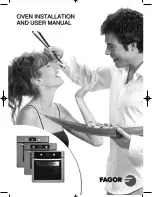
HOW YOUR MICROWAVE OVEN
WORKS
Microwaves are a form of energy similar to radio
and television waves. Your microwave oven is
constructed in such a way as to take advantage
of microwave energy.
Electricity is converted into microwave energy
by the magnetron tube, and microwaves are
then directed into the cooking area through
openings in the oven. Microwaves reflect off the
metal walls of the oven. They can be transmitted
through glass, paper, wicker and microwave-
safe cooking dishes. Microwaves do not heat
the cookware, though dishes will eventually feel
hot from the heat generated by the food.
Microwaves are attracted to the moisture in
foods and cause the water molecules to vibrate,
2,450 million times per second. This is called
absorption. As the water molecules vibrate they
rub against each other, producing friction. This
friction, in turn, causes the food to get hot. If you
have trouble imagining how this is possible, just
think how hot your hands would get if you
rubbed your palms together 2,450 million times
per second!
A very safe appliance:
Your microwave oven is one of the safest of all
home appliances. When the door is opened, the
oven automatically stops producing microwaves.
By the time microwave energy has been
converted into heat in the process of making
food hot, the microwaves have completely
dissipated.
GETTING THE BEST RESULTS
FROM YOUR MICROWAVE OVEN
Keeping an eye on things:
The recipes in this book have been developed
with great care, but your success in preparing
them depends upon how much attention you
pay to the food as it cooks. Your microwave
oven is equipped with a light that turns on
automatically when the oven is in operation. You
can see inside the oven and check the progress
of your food. Directions given in recipes to
"elevate", "stir", "rotate", etc., should be thought
of as the minimum steps recommended, for
evenness and speed in microwave cooking.
Factors affecting cooking time:
The cooking times given in the recipes in this
book are approximate. Many factors affect
cooking times. The temperature of ingredients
used in a recipe, makes a big difference in the
cooking time. For example, a cake made with
cold butter, milk and eggs will take considerably
longer to cook than one made with ingredients
that are at room temperature.
On very cold or very hot days, a great deal of
electricity is diverted for heating or cooling.
Therefore, less electricity is available for your
oven, and the food will cook more slowly than
usual.
Range of cooking times:
All of the recipes in this book give a range of
cooking times. In general, you will find that the
food remains undercooked at the lower end of
the time range.
You may sometimes want to cook your food
beyond the maximum time given. Personal
preferences vary, as do the cooking speeds of
different ovens under different conditions. While
undercooked food may always be cooked a bit
more, overcooked food can be ruined.
Some of the recipes, particularly those for
breads, cakes and custards suggest that food
be removed from the oven when it is still slightly
undercooked. This is not a mistake. When
allowed to stand, the food will continue to cook
outside of the oven, as the heat trapped within
the outer portions of the food gradually travels
inward. If the food is left in the oven until it is
cooked all the way through, the outer portions
will become overcooked. As you gain
experience in using your microwave oven, you
will become increasingly skillful in estimating
both cooking and standing times for various foods.
- 6 -
INTRODUCTION
Содержание MA7005ST
Страница 24: ...P NO 3828W5A8204 Printed in China ...







































